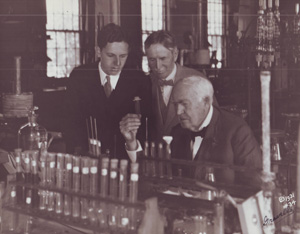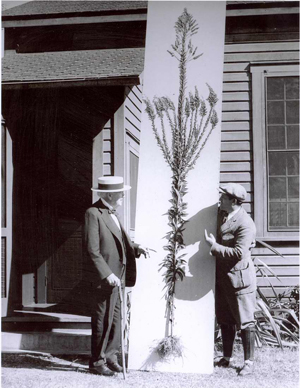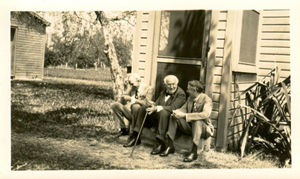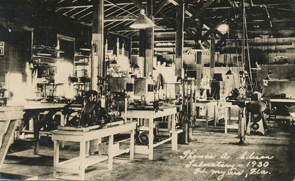Edison’s Golden Ticket: Goldenrod | Edison Botanic Research Corporation & Lab Part II
In the late 1920’s, the Edison Botanic Research Corporation (EBRC) was on a mission. Botanical specimen collectors scoured the countryside searching for trees, vines, bushes, and botanical specimens of all types so that the EBRC lab could test the potential of each plant for rubber production.

Thomas Edison, Harvey Firestone and son Roger inspect the contents of a test tube in the EBRC lab | Edison and Ford Winter Estates Archives
Which plant would produce rubber most efficiently? Believe it or not, the specimen that showed the most promise was a common weed called goldenrod.
Through careful cultivation and experimentation, Thomas Edison was able to cultivate a type of Goldenrod (Solidago Edisonia) which grew up to 12 feet high, and can still be viewed in the EBRC lab today!

A 12 foot tall strand of goldenrod | Edison and Ford Winter Estates Archives
Did you know that big changes are currently underway in the EBRC lab? Find out more in Part III of the Edison Botanic Research Corporation series.
To learn more about cultivating plants in Florida, visit the Edison and Ford Winter Estates propagating gardens.
For more information about requesting a copy of these images or any other images from the Edison and Ford Winter Estates archives, click here.
Mrs. Edison’s Old Fashioned Recipe for Chocolate Caramels
Old Fashioned Recipe for Chocolate Caramels
1 cup of milk
1 cup of molasses
1 small cup of butter (size of an egg)
2 cups of sugar
½ pound of chocolate
1 teaspoon of flour
2 teaspoons of vanilla
Combine milk, molasses and butter and let boil until butter completely melts, then add 2 cups white sugar, ½ pound of chocolate and a teaspoon of flour well mixed in a little water or milk.
Let it all boil for 30 minutes but after it has boiled 10 minutes, add 2 teaspoons full of vanilla – pour in flat buttered pan and cut in squares.

The Edisons’ recipes were written during their lifetime, therefore the directions, measurements and styles of the recipes reflect the period in which they lived and their personal tastes. Because the recipes are original for the times, you will want to read them carefully and experiment liberally. We know you will enjoy a look at heir lives as well as their scrumptious recipes.
Our collection of vintage recipes can be found in Edison’s Family & Friends Recipes which is available in the Edison and Ford Winter Estates Museum Store or online at https://www.edisonfordwinterestates.org/store/Edisons-Family-Friends-Recipes.html.
Origins | Edison Botanic Research Corporation & Lab Part I
Did you know that Henry Ford, Harvey Firestone, and Thomas Edison collaborated on a major research initiative?
Beginning in 1927, and with a research lab being built the following year, the Edison Botanic Research Corporation (EBRC) was created to find a domestic source for organic rubber.

EBRC founders Ford, Edison and Firestone sit on the front porch of the lab circa 1930 | Edison and Ford Winter Estates Archives
Why was organic rubber so important?
Having only recently emerged from the World War I, the three friends were only too aware of the volatile market fluctuations of the international rubber market. To secure a future source for rubber, the EBRC tested a variety of botanic specimens to determine their potential for rubber production.

Interior of the lab | Edison and Ford Winter Estates Archives
In typical Edison fashion, thousands of possible solutions were tested. Which produced the most rubber? We’ll tell you all about it in Part II of the Edison Botanic Research Corporation series.
To learn more about Edison, Ford & Firestone’s quest for rubber, check out Growing American Rubber: Strategic Plants And The Politics Of National Security by Mark R. Finlay, available in the Edison and Ford Winter Estates gift shop.
For more information about requesting a copy of these images or any other images from the Edison and Ford Winter Estates archives, click here.